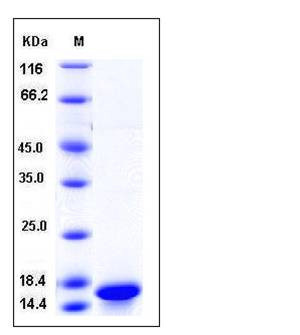Enterohemorrhagic E. coli (EHEC) stx2B / Shiga toxin II subunit B Protein (His Tag)
stx2dB,stx2gB
- 100ug (NPP3151) Please inquiry
| Catalog Number | P40019-E08E |
|---|---|
| Organism Species | E. coli |
| Host | E. coli |
| Synonyms | stx2dB,stx2gB |
| Molecular Weight | The recombinant E.Coli STX2B consisting of 95 amino acids and has a calculated molecular mass of 10.6 kDa. It migrates as an approximately 16 kDa band in SDS-PAGE under reducing conditions. |
| predicted N | Met |
| SDS-PAGE |  |
| Purity | > 98 % as determined by SDS-PAGE |
| Protein Construction | A DNA sequence encoding the E.Coli STX2B (Q93EY4) (Met 1-Asp 89) was expressed, with a polyhistide tag at the N-terminus. |
| Bio-activity | |
| Research Area | Neuroscience |Cell Type Marker in Neurodevelopment |Neuronal Cell Markers |Synapse & Synaptic Proteins |Presynaptic Active Zone Proteins |
| Formulation | Lyophilized from sterile PBS, pH 7.4 1. Normally 5 % - 8 % trehalose and mannitol are added as protectants before lyophilization. Specific concentrations are included in the hardcopy of COA. |
| Background | E. Coli STX2B is a subunit of Stx2. Stx2, together with Stx1, formed a family of related toxins which are known as shiga toxins. Shiga toxins are mainly produced by the bacteria S. dysenteriae and the Shigatoxigenic group of Escherichia coli, which includes serotypes O157:H7, O104:H4, and other enterohemorrhagic E. coli (EHEC). A total of 3222 outbreak cases (including 39 deaths) have been reported in northern Germany in May through June 2011. The outbreak strain was typed as an enteroaggregative Shiga-toxin–producing E. coli O104:H4, producing extended-spectrum beta-lactamase. The toxin has two subunits—A and B. E. Coli STX2B is the B subunit. It is a pentamer that binds to specific glycolipids on the host cell, specifically globotriaosylceramide. Following this, the A subunit is internalised and cleaved into two parts. Stx2 has been found to be approximately 400 times more toxic (as quantified by LD50 in mice) than Stx-1. The Stx1 and Stx2 B subunits form a pentameric structure that binds to globotriaosylceramidereceptors on eukaryotic cells and promotes endocytosis |
| Reference |
